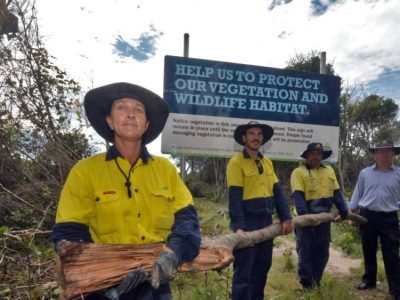COASTAL CULTURAL MODELS – LANDSCAPE PERSPECTIVE

“NOT ON OUR WATCH”: Port Macquarie-Hastings Council director Matt Rogers, right. (pc: www.camdencourier.com.au)
Both Thompson (2007) and Stocker and Kennedy (2009) in their respective papers in the journal Coastal Management look at issues arising from the importance of landscape views in producing social conflict in coastal decision making. Thompson uses the phrase “visual consumption” to define circumstances where the property owner seeks the right or permission to engage in the act of viewing the sea, beach, foreshore, waterway, cliffs etc. without “ interference from others”. He goes on to add:
This seemingly benign act, viewing, is actually very spatially intrusive and problematic in many ways. From his or her owned vantage point, the shoreline property owner is actually using a vast amount of space that he or she does not own… the property owner might object on aesthetic grounds to all sorts of activities that occur on the beach or over many miles of ocean (p. 222).
What it often boils down to is that a view is worth money! There is a price that can be paid for the privilege of commanding a view. As noted by Stocker and Kennedy, this motivates many people who purchase coastal property; they are prepared to push hard to retain that so-called right including a preparedness to engage in bitter battles over the erection of structures that can later interfere or intrude upon a view. Loss or perceived loss of the view or perceived right to a view may be seen a creating a loss of property value and hence personal wealth. Around Sydney Harbour this can lead to expensive appeals to the Land and Environment Court to stop or modify a development application, especially if such a development will block “ iconic” views of the Harbour Bridge or the Opera House. Thompson cites legal decisions in the USA where damages have been paid for loss of view including a California case where compensation was awarded where a reasonable expectation of continuation of view was destroyed and hence there was a loss of market value.
Conflicts over views can erupt under a range of circumstances. In USA and Europe wind farms in the sea have been seen as intruding upon the sense of an infinite horizon. In western Victoria the construction of turbines along the coast was seen by many as ugly and intrusive, but wind farms get bad press anywhere! The property purchaser may seek to retain their view domain forever and will object to whatever invades the space beyond their legal boundary that adversely affects what they deserve they have paid for.
The scale of intrusion may become very local especially in urban areas where foredunes come and go in association with periodic beach and dune erosion. Established dunes may have a dense shrub and tree cover. Their presence will by definition serve not just as a buffer to erosion events but also as a natural screen to wind and blowing sand. But they can obstruct views. The fight for and against vegetated dunes is manifest in New Jersey especially after natural disasters such as Hurricane Sandy. But we see the same battles around our precious shores. Surfers and surf clubs want to see the beach and surf zone; they prefer grassy dunes to those with shrubs. The presence of dense native shrubs is seen by some as a place of social evil! Removing trees and shrubs may also be the preference of some land owners seeking a view of the ocean or waterway. Both groups will clash with the Dune/Coastcare groups who get grants to plant native shrubs and fight for their retention. I know of one case where federal money to an established council-based Coastcare group had their plants removed on instructions from the same council after adjoining property owners complained and wanted the foredune cover replaced by Kikuyu grass at council’s expense!
The question is how do much weight should coastal communities and decision makers place on those who push hard for the landscape perspective. This is often a matter for local politics. Council majorities in favour of supporting vocal residents can be over turned at a subsequent election when those with a more ecological perspective come into power. On top of this is the question of what constitutes an acceptable coastal landscape. For some the yellow flowering bitou bush is lovely and so are the rows of statuesque exotics such as Norfolk Island Pines. For newcomers, and those who planted the exotics, such landscapes are to be protected. But this is bad news to those who take a different perspective so it is quite likely if not inevitable that social conflict will continue.
Words by Prof Bruce Thom. Please respect Bruce Thom’s thoughts and reference where appropriately: (c) ACS, 2016, posted 5th October 2016, for correspondence about this blog post please email admin@australiancoastalsociety.org


 COASTAL CULTURAL MODELS – OMMODITY PERSPECTIVE
COASTAL CULTURAL MODELS – OMMODITY PERSPECTIVE